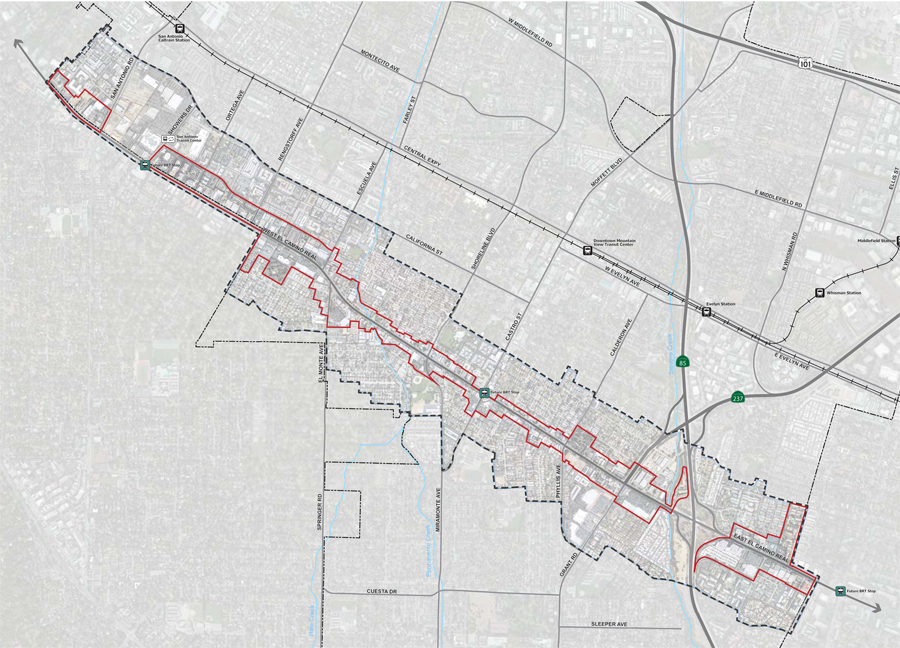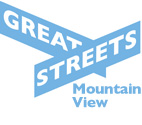It may be hard to imagine El Camino Real as a Great Street, but the City of Mountain View has begun work on a focused plan for El Camino Real to address housing, land use, mobility, and design options. Known as a “precise plan,” city officials and council will work over the next twelve months to identify opportunities and refine alternatives for the future of El Camino.
One of the first public meetings is a city council study session on Tuesday, October 15 at 6PM at City Hall, where high level strategies will be discussed to improve bicycle and pedestrian safety and access both on El Camino and from the surrounding neighborhoods. No decisions are made at Study Sessions but public input is taken and considered by City Council.

The plan area encompasses 222 acres and runs the entire 3.9-mile length of the El Camino Real corridor in Mountain View. The plan area includes the majority of parcels fronting El Camino Real plus additional parcels adjacent to the corridor.
El Camino Real is currently outside the boundaries of the Great Streets focus area, but the El Camino Real Precise Plan is an opportunity to build on the pedestrian, bike, and people-friendly streets central to the Great Streets vision and we’re interested in taking a closer look at some of the opportunities for the corridor, especially for biking. We’ve identified some of the issues below, but would love to hear your ideas in the comments and hope you share them with city council.
BIKING
The recently adopted city-wide planning blueprint, known as the General Plan, envisions El Camino Real as a “vibrant transit and pedestrian corridor” and bicycling is deemphasized since the street has heavy, fast-moving traffic, with many trucks. Only the fearless confidently pedal El Camino Real, but others ride the sidewalks since there’s often no other route, which endangers pedestrians and complicates bike trips. However, with new development slated for El Camino, and numerous existing retail destinations, strong bike access could play an important role on the street. Alternatively, parallel neighborhood streets such as Latham/Church could prioritize bicycling, but some destinations on El Camino would still be difficult to reach.
WALKING
While bicycle improvements are debated, the need for better pedestrian access is undisputed. Pedestrian crossings on El Camino are few and far between, with a half mile between some crossings. Crosswalks can feel dangerous with drivers not stopping for pedestrians and the walk sign set for only the healthiest and fastest walkers. Additionally, sidewalks are narrow, with poor lighting and the concrete is marred by years of neglect. The Precise Plan will set standards that increase the sidewalk width, but there may be additional elements to improve pedestrian safety and access.
TRANSIT
“Improved transit performance,” was identified by the city as a key goal for El Camino, but with the numerous barriers to biking and walking on El Camino Real complicates transit use before you even reach the bus stop. While larger projects such as VTA’s Bus Rapid Transit Project will be debated in the future, transit use in general will be suppressed without safe, direct, and attractive walking and biking routes to transit.
Let’s discuss what bicycle and pedestrian improvements could make El Camino a Great Street. Leave a comment below or send a note to council! You can also get in touch with lead city officials for this project here.

How do you justify saying bikes on sidewalks endangers pedestrians? Motor vehicles park and drive on sidewalks every day and that REALLY endangers both pedestrians and bicyclists. Curbs don’t stop them. And sidewalks that are too narrow, in ill repair and have sign poles in the middle of them endanger pedestrians. So do bicyclists, joggers and other pedestrians if they don’t use common sense, but that is true anywhere. What is needed is wider sidewalks and paths and better maintenance (often ignored in budgets) not sentencing bycyclists to death by pushing them onto a chaotic 8-lane highway (El Camino). Get some perspective!
Tim,
Sidewalk bike riding is an issue that we hear a lot from our neighbors who walk around town frequently, especially for those who aren’t as nimble, cary lots of items with them, or have kids in tow. Obviously, there are numerous other issues related to driver behavior, road design, and car use on El Camino, and sidewalk riding isn’t the primary issue keeping the corridor from greatness. However, we firmly believe that one of the solutions to promote safer streets is to provide convenient and safe bicycle facilities so bike riders don’t feel like the sidewalk is the only refuge for getting from A to B. This is good for all road users, but El Camino comes with unique challenges and we want to dig deeper as the Precise Plan moves forward. The good news is that wider sidewalks were identified by the city as a key component for El Camino in the General Plan, and the new developments sprouting up and down the corridor have much better pedestrian frontages. 5
Rather long, sorry:
I’m getting a little confused about our semantics and time frames. A “roadway” is the area between curbs, including any “bike lines” or parking spaces. The “sidewalk” is a navigable part of the “corridor” that is not part of the roadway and also not a parking lot, driveway “bike path”, or someone’s doorstep.
You are discussing a future environment (to be preceded by years of potentially dangerous construction). But what people are saying about bikes on sidewalks is based on their experience with a CURRENT REALITY, and along El Camino the sidewalk IS THE ONLY REFUGE from deadly road conditions. I ride only short distances on sidewalks and always show courtesy to pedestrians, slowing down, pulling over or stopping according to their needs to facilitate their right of way. When walking I don’t remember ever being crowded by a bicyclist coming too close or fast on a sidewalk; I think reckless bikers prefer the road where they can go faster. Sharing our limited sidewalk space is not ideal but a temporary necessity until the future arrives. Our sidewalks are too narrow anyway and we may feel crowded by the many objects that restrict our paths. These include lamp posts, electric boxes, service vehicles, trash cans, recycling bins, leafblowers, sidewalk discontinuities, litter, trees, sign posts, bus shelters, shopping carts, real estate signs, suitcases, wheelchairs, bicycles, and other people who are walking, standing or sitting. I can’t help but think the real problem is the crowded feel of our sidewalks and that if we solved that problem both the real and perceived hazards would go away. Then we’d all be happier, which would also be good for business along the corridor.
My concern is a blind spot in which bicyclists are banished from public spaces and told to take their chances on a road where hazards to bicyclists are severe. A proposed narrow bike lane in the door zone won’t help that. Drivers make better arguments for bicyclists being a safety hazard on the roadway. The planners want to encourage us to walk AND bike, to patronize new businesses on El Camino. This doesn’t mean biking fast or long distances, just getting there. I don’t think it requires antiseptic segregation of bicycling and walking. You can channel modalities without hard barriers by designing enough of the right kinds of spaces to accommodate both modalities, along with electric wheelchairs, comfortably. We have such a narrow concept of “sidewalks” after years of being starved by inadequate setbacks. We can broaden our consciousness to design a “people-way” that is more broadly functional than a “sidewalk”. I’m in favor of semi-structured multi-use pathways that interconnect wider zones and accommodates all non-automotive modalities. This requires more than the proposed 5 feet actual clear width (“7 feet”, minus 2 feet for the lamp pole) that was suggested in a “Precise Plan” document. One way to get more space is get rid of the 12 feet of “stairways” by requiring ground level first floors in all buildings.